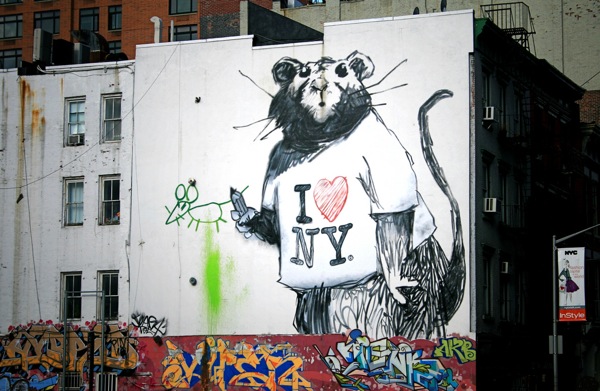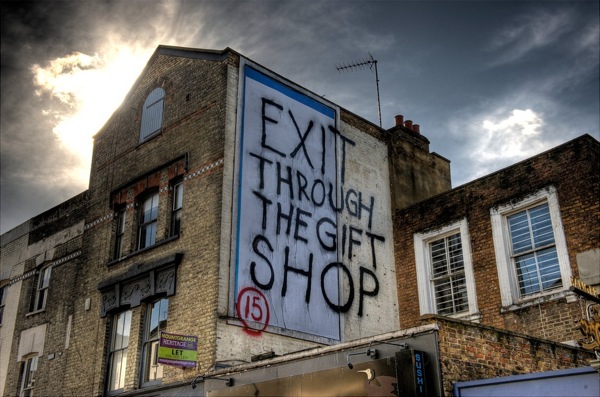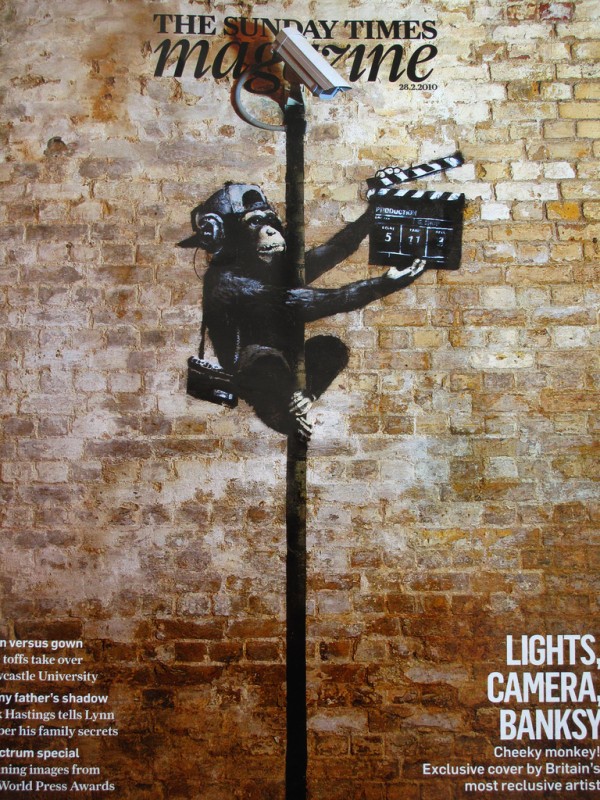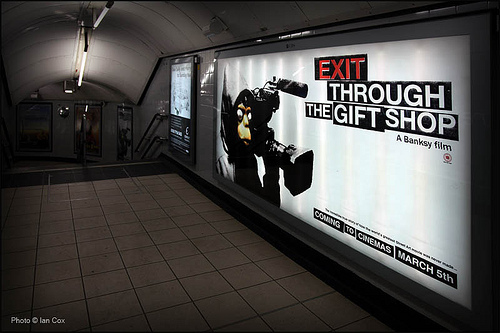The Art Newspaper reports that Banksy versus The Bristol Museum was one of the world’s top 30 most-visited exhibitions in 2008/2009, averaging nearly 4000 visitors a day. More on BBC News.
The Art Newspaper reports that Banksy versus The Bristol Museum was one of the world’s top 30 most-visited exhibitions in 2008/2009, averaging nearly 4000 visitors a day. More on BBC News.
Black Rat Projects (formally Black Rat Press) finally has their first show of 2010 opening in a few weeks. It’s called Now’s The Time. It’s a group show and it brings together artwork by some of the top names in street art’s history: Jean-Michel Basquiat, Keith Haring, Shepard Fairey, Swoon, Banksy, Barry McGee, Faile and Os Gêmeos. I’ve heard about this show coming together over the last few months, and I like to joke that the idea behind it is strikingly similar to The Thousands, but two artists really separate this show from The Thousands and other similar exhibition that have been put on in the past: Keith Haring and Jean-Michel Basquiat. It’s not often that a gallery has put on an exhibition of what is claimed to be the world’s top street art and been able to include those two essential artists in the line up alongside newer artists artists like Faile. This is going to be a very interesting show. Now’s The Time opens April 22nd at Black Rat Projects in London.
Via Pimp Guides

Don’t Panic, the a free UK magazine, has a poster by Banksy available this week’s Don’t Panic Pack. It’s a nice free way to get his “Forgive Us Our Trespassing” stencil. On the other side of the poster, there is an ad for Exit Through The Gift Shop, so get two packs, that way you can display both sides. More info on Don’t Panic’s website.
I’m pretty sure that I’m the only journalist/blogger/whatever to have taken a video camera inside Banksy’s Leake Street cinema, where he hosted the UK premiere of Exit Through The Gift Shop. If you didn’t have a chance to see the cinema in person, here’s your chance to check it out:
And S.Butterfly has a great set of photos from inside the cinema.
Note from RJ: The following is a guest post by Jordan Seiler of Pubic Ad Campaign. The opinions are entirely his own, but I did ask him to write this post. I was asking myself the same questions that Jordan has considered, and I knew that he could provide a more intelligent analysis of the situation than I’m able.
Is this new Banksy Street Art or advertising, and does it even matter when it manipulates the public and negatively affects people’s relationships to the streets that surround them?
It is my contention that Street Art’s positive affect on the viewer and therefore the public in general is directly related to the producer’s intent to manipulate for self-interest. For pedestrians, the appropriation of public space by advertisers and artists is an interruption to the normal architecture of the city. When that interruption has no clear expectation of the viewer, the work becomes a point of dialogue and conversation between two unknown parties. It is as if a gift has been left behind to be appreciated or forgotten according to the viewer’s discretion. When that interruption is motivated by self-promotion, as in the case of advertising, this dialogue becomes a monologue that demands the viewer recognize a specific person, product, or thing. It would seem the intention of the imagery put in our public spaces can create two very different reactions in the viewer to the space itself.

Banksy is a hard nut to crack. His work very successfully uses the street to do what good Street Art always does, create moments of interaction and dialogue between public individuals where once a barren emptiness stood. And yet I often find myself wanting give him shit for some of the stunts he pulls (for example the above rat painted by Colossal Media) because they ride a thin line between being good street art and the work of someone with money to burn and a staff to pull off his antics. For me, having someone else do your work for you seems too close to advertising and therefore a manipulative abuse of public space. But this is clearly my personal opinion. As the Banksy machine grows in size and scope, the line he walks becomes ever more treacherous as possibilities to taint his street credibility multiply. The upcoming release of Exit Through the Gift Shop, and its subsequent promotion on Portabello Road in London, is a good example of this thin line we expect Banksy to carefully navigate. More importantly, it provides us with some insight into when street art has abandoned its initial interest in creating dialogue in favor of an outright promotion of the artist, and how that affects the public.

I was recently made aware of the above “advertisement” on Portabello Road in Notting Hill. It seems to be the work of Banksy, or his PR firm, and promotes the upcoming release of his new documentary film. What stood in this location before the infamous vandal got his hands on it was a more traditional advertisement. To me this reinforces the notion that indeed Banksy has started advertising for himself. If so, this is an interesting juxtaposition to earlier works attributed to Banksy, which include this YouTube anti-advertising piece done over a blank advertising frame. Although Banksy may not be at work in this video, writing “The joy of not being sold anything” on a billboard is something we could expect out of an artist who describes his relationship to outdoor advertising like this:
Any advertisement in public space that gives you no choice whether you see it or not is yours. It belongs to you. It’s yours to take, re-arrange, and re-use. Asking for permission is like asking to keep a rock someone just threw at your head.
– Banksy in his book “Cut It Out”
This advertisement makes me want to get up there and buff it, a reaction against this piece and how it uses public space. One could argue that Banksy has crossed a line here by using public space for outright promotion instead of artistic practices and that this should affect how people see his work. Some would say that this line is dependent on whether or not Banksy has paid for this space or not. If he has rented the billboard, then he is simply promoting his personal agenda by buying public space, which seems counter intuitive to Banksy’s interests. If he has not rented the space and this appropriation of advertising real estate was done without permission in typical street art fashion, then is he simply continuing a long history of public appropriation?
Whether or not this Banksy piece is good or bad, art or advertising, tainted by the hypocrisy of advertising for himself using street art, or bettered by his wholesale appropriation of the public for his own means, is open for debate. To me the answer to the argument lies in the larger question of how we utilize public space productively so that our artwork creates more interactions and public relationships, instead of separations and points of friction.
The notion of intention as it is applied to artists and advertisers’ self interest when appropriating the public environment might reveal how the public receives the work and what benefits the work might have for the public at large. As I said before, both of these visual forms in public are interruptions, and maybe even distractions, so they have a serious affect on the way the public experiences its space. That said there are four examples of intention that create reactions with varying degrees of animosity or endearment for the viewer. These examples apply directly to advertising and art and I believe explain how visual works can affect the public’s feelings of separation or connectedness to public spaces.
So Advertisement, intending to distract you for its own purposes, creates a conflicted interaction where the viewer recoils from an environment that is manipulative. Good Street Art, with an interest in dialogue and two way communication, builds relationships by integrating the viewer into his or her experience of public space. Banksy’s traditional street work, intending to interrupt your day for the sake of communication is therefore experienced as a positive use of public space and leaves the viewer happy about his or her serendipitous run in. Alternatively, Banksy’s use of public space to promote his upcoming movie, whether intending to or not, is a use of public space for self-interest and therefore manipulative to the viewer. Whether or not this is advertising or Street Art is really not the question so much as is this a poor use of the public environment by an artist whose long history or work should have taught him better? To someone who greatly appreciates Banksy’s Street Art this image tarnishes the shine on much of his work. For someone who is unfamiliar with the artist it is just another image on the wall repeating a self-interested meme.

So Banksy is on the cover of Time Out London this week, which is pretty awesome of Time Out, and Banksy seems to be acknowledging that he has been embraced by the most gentrified segments of society, which is pretty honest of Banksy.
The real treat is inside the magazine though. Banksy has been interviewed by Ossian Ward, the editor of Time Out London’s art section. The full interview has been posted online, and here are some excerpts:
What’s this battle with Robbo and Drax all about, then?
‘I didn’t deliberately start a battle with Robbo – have you seen the size of him? In the ’90s him and Drax were infamous enough that we’d even heard about them in Bristol. The truth is I didn’t paint over a piece that said ìRobboî, I painted over a piece that said “nrkjfgrekuh”. But either way, I don’t buy into the idea a wall “belongs” to a certain writer, or anyone else for that matter.
…
Can street art ever be shown in a gallery?
‘I don’t know if street art ever really works indoors. If you domesticate an animal, it goes from being wild and free to sterile, fat and sleepy. So maybe the art should stay outside. Then again, some old people get a lot of comfort from having a pet around the house.
‘It’s hard to capture the adrenaline of street painting when you’re in a nicely lit studio with the kettle on. Maybe the people who steal graffiti off walls are on to something – the edge is still there. But those people are funny – they ask me for a letter of authentication saying I painted a certain piece, but that’s basically a signed confession on headed notepaper.’
…
What do you make of the financial value of your works? Do you mind people trading them like property or luxury goods?
‘My lawyer’s opinion is that the cops might not actually be able to charge me with criminal damage any more – because theoretically my graffiti actually increases the value of property rather than decreasing it. That’s his theory, but then my lawyer also believes wearing novelty cartoon ties is a good look.’
Read the rest on Time Out’s website…
Time Out have also contacted a number of street art bloggers (including Vandalog) for the locations of the best street art in London and Ian Cox has put together a selection of some of his favorite photos.

This week’s issue of The Sunday Times Magazine has a really nice cover designed by Banksy. The magazine also includes an article on the artist and an interview.
The article covers such a wide range of topics from his identity and personal life to the art market to why CCTVs are irritating, so I’m not even going to try and pick out my favorite bits. The article is a good read though, and if you’re not completely sick of Banksy-mania, it’s worth reading. You can find it online here.
On a related noted, The Times had an article on Saturday about Mr. Brainwash and Exit Through The Gift Shop. It’s probably the best article I’ve read so far to look at Mr. Brainwash as a person and artist in an unbiased and thought-provoking manner. They even speak to MBW himself and get his take on the film, which definitely strays from the official story. You can read that article here.
Photo by Annar_50

Next week’s issue of Time Out London will feature a cover designed by Banksy. The full cover image hasn’t been released yet, but the above teaser is interesting. Time Out says “This photo shoot, a mixture of self-portraiture and his trademark use of spraypaint, is unlike anything he’s ever done for a magazine before and may never be repeated.”
In addition to the cover, Time Out has an interview with Banksy.
Because this issue is sure to be popular with art fans, Time Out are also selling a version of the magazine without the Time Out logo on it and that includes a 68 x 51 cm poster of the cover art for £12.99. That’s for sale at their online shop.
Yes, I realize that I sound like a press release, but I figure this is pretty cool if you’re not worried about Banksy becoming too mainstream. And if you are worried about that, read the Hank Willis Thomas interview in the latest issue of Juxtapoz.

On Tuesday evening, I had the chance to see Banksy’s film Exit Through The Gift Shop (in cinemas March 5th) at the pop-up cinema he has put together in the tunnels next to Leake Street (where he held Cans Festival). It was an experience that I’ll never forget.
Outside the entrance, Banksy has painted a red carpet onto the street. Inside, it’s like a mini-exhibition. A mix of new and old works, the highlight for me was the “Paranoid Pictures” logo which has been stenciled onto one of the walls. Or maybe it was the animatronics from Banksy’s Pet Store show. It’s tough to say. But the art got everybody in the mood to watch what we’d been invited there for: something that involved Banksy, a video camera and Mr. Brainwash. Beyond that, most of us were in the dark as to what exactly was going to be shown.
Here’s the spoiler-free review:
Exit Through The Gift Shop is not going to be the Subway Art of street art (Beautiful Losers and Bomb It have already attempted that anyways…), and it’s not trying to be. It’s not “The Banksy Movie” either. And I think that’s going to disappoint a few people. But if you’re a regular reader of Vandalog, you probably like street art, not just Banksy. Exit Through The Gift Shop is a film that you’ll enjoy.
The film is a documentary that comes across as a mockumentary. I’ve heard people plenty of people compare it to Spinal Tap or Borat. But everything in Exit Through The Gift Shop is more or less true. Of course, I’m sure certain half-truths are told, but it’s about as factual as you can get when it comes to talking about anonymous artists. The important thing here is that all the characters are real people, and the events on film actually happened and were unscripted, so that seems real enough to me.
There’s a line every five minutes that might be quoted by street art fans for years to come: Some of them are funny, some are poignant and some are depressing. The whole film is mixture of comedy, drama and tragedy, but every angle will be compelling to street art fans.
The big problem though, is that I just can’t imagine telling my friends who don’t like art or film to check out the movie. It’s not like Spellbound or (in my opinion, not that of my friends who stopped talking to me after a certain movie night…) Helvetica; if you don’t like street art (or at least art or documentary films in general), you may just be left confused and bewildered by the whole thing. I suppose that’s the point, but last time I checked, Banksy’s work isn’t supposed to confuse people, it’s meant to be clear, direct, funny and hopefully provocative.
And where the film could have most interested audiences outside the street art world, examining how money and marketing plays a role in the art market, Exit Through The Gift Shop hints at these issues, but falls short of actually confronting the subject head on, leaving the audience to consider the consequences. While people certainly are smart enough to see what’s going on and figure these things out for themselves, I think Banksy could have been a bit more direct about the whole thing.
Perhaps the film’s greatest flaw is that it ends on more of a decidedly bleak pop than a spectacular bang or even just a hopeful note of any sort.
Minor issues aside, most street art fans will absolutely love this film. It is hilarious, has behind-the-scenes footage of Banksy and other great street artists at work and tells a story that needs to be told. I can’t say much more without spoiling the plot.
Okay, and now for a spoiler after the jump… Continue reading “Exit Through The Gift Shop review and spoilers”
It looks like Team Robbo isn’t done with Banksy just yet. If you don’t know the story, you catch up with this video from a couple of weeks ago. And here’s the latest action by Team Robbo: